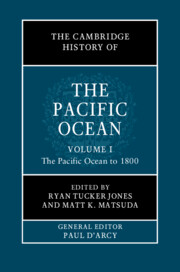Book contents
- The Cambridge History of the Pacific Ocean
- The Cambridge History of the Pacific Ocean
- The Cambridge History of the Pacific Ocean
- Copyright page
- Contents
- Figures
- Tables
- Contributors to Volume I
- Frontispiece
- General Editor’s Introduction
- Preface to Volume I
- Part I Rethinking the Pacific
- Part II Humans and the Natural World in the Pacific Ocean
- Part III Deep Time: Sources for the Ancient History of the Pacific
- Part IV The Initial Colonization of the Pacific
- Part V The Evolution of Pacific Communities
- Part VI Europe’s Maritime Expansion into the Pacific
- 28 Iberian Conceptions of the Pacific
- 29 Naval Rivalry in the Western Pacific: Portugal, England, Holland, and Koxinga, 1600–1720
- 30 The Resurgence of Chinese Mercantile Power in Maritime East Asia, 1500–1700
- 31 The Enduring Sea Cultures of Southeast Asia, Seventh–Seventeenth Centuries
- References to Volume I
- Index
30 - The Resurgence of Chinese Mercantile Power in Maritime East Asia, 1500–1700
from Part VI - Europe’s Maritime Expansion into the Pacific
Published online by Cambridge University Press: 11 November 2022
- The Cambridge History of the Pacific Ocean
- The Cambridge History of the Pacific Ocean
- The Cambridge History of the Pacific Ocean
- Copyright page
- Contents
- Figures
- Tables
- Contributors to Volume I
- Frontispiece
- General Editor’s Introduction
- Preface to Volume I
- Part I Rethinking the Pacific
- Part II Humans and the Natural World in the Pacific Ocean
- Part III Deep Time: Sources for the Ancient History of the Pacific
- Part IV The Initial Colonization of the Pacific
- Part V The Evolution of Pacific Communities
- Part VI Europe’s Maritime Expansion into the Pacific
- 28 Iberian Conceptions of the Pacific
- 29 Naval Rivalry in the Western Pacific: Portugal, England, Holland, and Koxinga, 1600–1720
- 30 The Resurgence of Chinese Mercantile Power in Maritime East Asia, 1500–1700
- 31 The Enduring Sea Cultures of Southeast Asia, Seventh–Seventeenth Centuries
- References to Volume I
- Index
Summary
During the eighteenth century, ethnic Chinese emerged as the pre-eminent diasporic community in maritime East Asia. From the East China Sea to the Strait of Melaka, Chinese junks dominated the trading lanes, carrying silk, porcelain, and tea from China, copper from Japan, and Southeast Asian natural resources to ports across the region, from Guangzhou to Banjarmasin. Immigrants flooded into the sparsely populated interior of Southeast Asia, where they opened up land for cash crops and engaged in mining. Leonard Blussé, Carl Trocki, and other scholars have spoken of the eighteenth century as a ‘Chinese century’ in maritime East Asia.1 Their activities in the region would presage an even greater influx of Chinese capital and labour after 1850. However, the underlying factors behind this pre-eminence have not yet been systematically studied. Although Chinese merchants and immigrants have long had an established presence in maritime East Asia, at least since the thirteenth century, their actual numbers and degree of influence, as Anthony Reid has shown, varied over time.2 In fact, their communities often had to coexist and contend in a multipolar environment with other diasporic groups that enjoyed greater strength in numbers and prestige.
- Type
- Chapter
- Information
- The Cambridge History of the Pacific Ocean , pp. 675 - 697Publisher: Cambridge University PressPrint publication year: 2023
- 1
- Cited by



